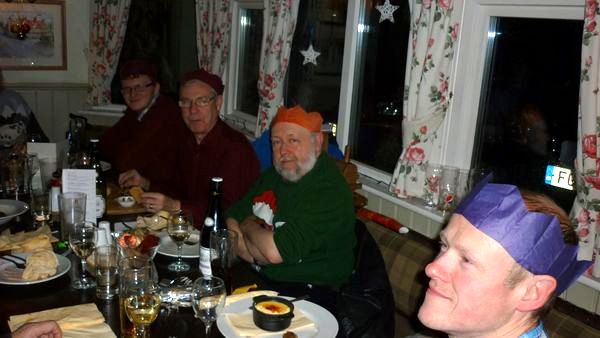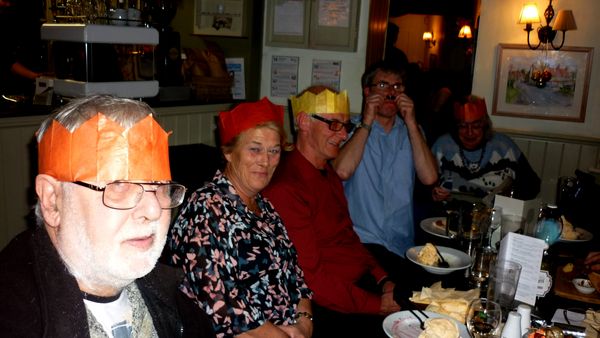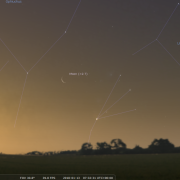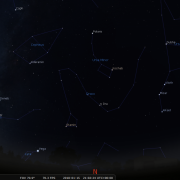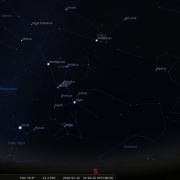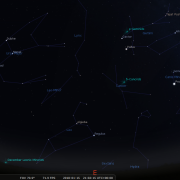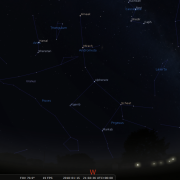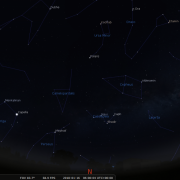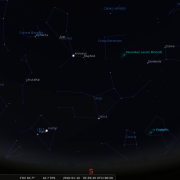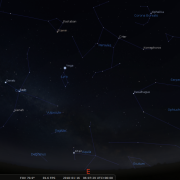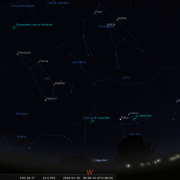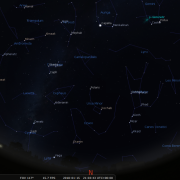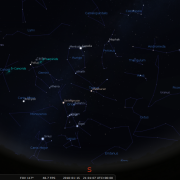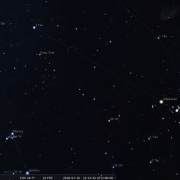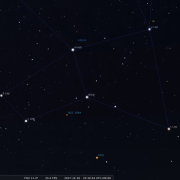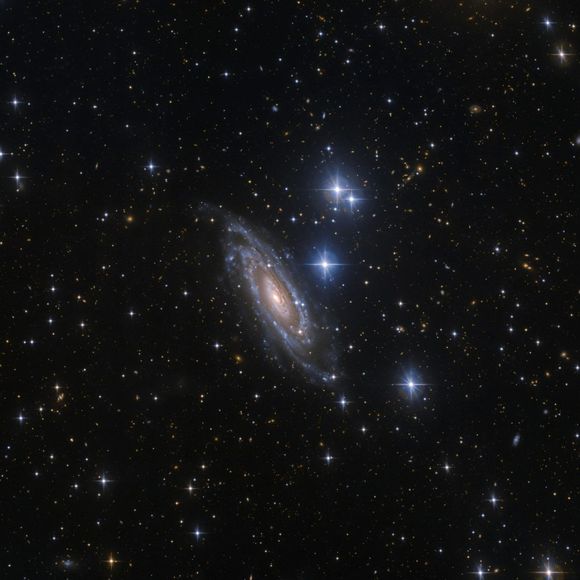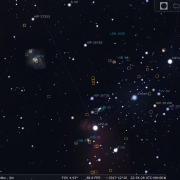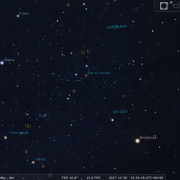✭✭✭ A Happy New Year to All our Members ✭✭✭
In this issue, Mark continues his new series of "Crossing the Line" series of objects: a star, a galaxy, a nebula and a cluster. Don't forget the Society Meeting is on Tuesday 9th January 2018 (2nd Tuesday of Jan)!
Welcome to the WDAS monthly newsletter for January 2018: a digest of the month's latest contributions to our website. Below you'll find Society News, Sky Notes and In-Focus articles printed in full. There's also future events, and trailers for other articles which appear in full on the website - just a click away!
Society News
Our Christmas meal at the Hare and Hounds once again proved a great success with ten members making it to the banqueting table.
The food was excellent, the wine flowed (favouring certain parts of the table more than others) and the company, most convivial. Crackers, crackers it has to be said seem to get worse each year, a few didn’t even contain a paper hat! The slug balancing kit was quite innovative though (you may be able to spot it on one of the photo’s)
Here’s to 2018!
Sky Notes
In this month's Sky Notes:
- Planetary Skylights
- Earth Reaches Perihelion
- Supermoon and Blue Moon
- New Year Meteors
- January 2018 Sky Charts
Planetary Skylights
The start of a new year sees the darkest mornings with sunrise not occurring until well after 20:00h. Normally you would moan (and you still might) about the low lumens, but if skies are clear for these January mornings the unfolding planetary action across in the south and southeast may tempt you out without the need to rise during the middle of the night to observe it! Jupiter, Mars, Mercury and Saturn are all to be located during the month, with some particularly close encounters to enjoy.
Evening
 To start off, look for brilliant Jupiter low to the south around 07:00h during the first week of January – it will be the brightest object on show.
To start off, look for brilliant Jupiter low to the south around 07:00h during the first week of January – it will be the brightest object on show.

 The orange ‘star’ to the right of Jupiter is Mars, which edges ever closer to Jupiter during this period. By the 6th and 7th the pair look exceedingly close to the naked eye. Viewed through a telescope at low power you should be able to frame both in the same field of view. The pair then go their separate ways, Jupiter westwards, with Mars sliding down toward the ‘other’ conspicuous and real star, Antares in Scorpius. On the 11th a crescent Moon lies above both planets. View around 07:00h.
The orange ‘star’ to the right of Jupiter is Mars, which edges ever closer to Jupiter during this period. By the 6th and 7th the pair look exceedingly close to the naked eye. Viewed through a telescope at low power you should be able to frame both in the same field of view. The pair then go their separate ways, Jupiter westwards, with Mars sliding down toward the ‘other’ conspicuous and real star, Antares in Scorpius. On the 11th a crescent Moon lies above both planets. View around 07:00h.
 Also during the first week, look down lower left of Jupiter of Mars where just above the SE horizon you will, with luck and location, spot elusive Mercury. Luck, because the horizon will have to be clear of cloud, and location for similar reasons – ie unobstructed, no buildings or trees etc. Mercury should be quite conspicuous to the naked eye, but use binoculars if you cannot initially track it down. View around 07:30h.
Also during the first week, look down lower left of Jupiter of Mars where just above the SE horizon you will, with luck and location, spot elusive Mercury. Luck, because the horizon will have to be clear of cloud, and location for similar reasons – ie unobstructed, no buildings or trees etc. Mercury should be quite conspicuous to the naked eye, but use binoculars if you cannot initially track it down. View around 07:30h.
 Then, between the 10th and 14th, look for Saturn emerging into the dawn sky, sliding up and right of Mercury. The two are closest on the 13th with Saturn just above Mercury. Good hunting.
Then, between the 10th and 14th, look for Saturn emerging into the dawn sky, sliding up and right of Mercury. The two are closest on the 13th with Saturn just above Mercury. Good hunting.
Earth Reaches Perihelion
Finally, on Jan 3rd Earth reaches Perihelion (closest to the Sun in its orbit) some 91.4 million miles or 147 million km distant. It’s the tilt of the Earth’s axis which gives rise to the colder, dark, short winter days, not the distance from the Sun, which many people still assume is the reason.
Supermoon and Blue Moon
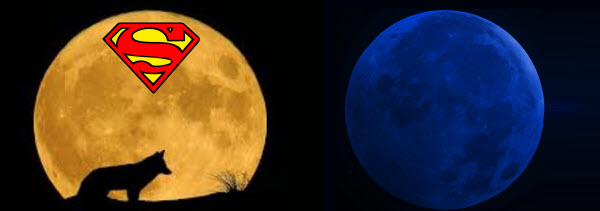
January sees two full moons; the first on the 2nd being close to Lunar perigee will no doubt be called a ‘supermoon’ by the media as it will appear a tad larger. The second full moon on the 31st is known as a ‘blue moon’ – the second full moon in a month. It will not look blue, and as there is another ‘blue moon’ in March, it is not that rare this year either.
New Year Meteors

The year starts with one of the more prolific meteor showers, the Quadrantids, active between Jan 1- 6th. The short lived shower peak normally falls over the night of 3rd/4th, with best rates witnessed in the small hours; 02:00-04:00h. Peak zenith hourly rates can reach 100 plus per hour, but actual observed rates by an individual will be substantially less, more so this year as a near full moon will severely curtail numbers. You should still spot a few Quadrantids however, which are often, fairly swift, producing occasional yellow-green fireballs.
Quadrantids appear to radiate from the now defunct constellation of Quadrans Muralis, which was removed from sky charts in 1922, but used to lie at the junction between Hercules, Bootes and Ursa Major. This position in the sky is located low to the N at the time of the peak, so do not concentrate on this aspect if viewing.
December's Geminids Report
For once clear skies coincided with the peak of the Geminid meteor shower, much appreciated by all meteor observers. John Lamb spent several hours armed with camera in the Upgang ravine (golf club) and reported seeing over 50.
Mark, (who spent the first half of the night at work) could only manage 15 minutes around 02:40h watching from home out of the patio doors - facing north. He recorded seven, but both saw a particularly bright Geminid streak through Cassiopeia at approximately 02:45h – perhaps mag -3, blue white in hue.
January 2018 Sky Charts
|
Looking North
Mid-January - 21:00h |
Looking South |
|
Looking East
Mid-January - 21:00h |
Looking West
Mid-January - 21:00h |
| Looking North (morning) Mid-January - 06:00h |
Looking South (morning) Mid-January - 06:00h |
| Looking East (morning) Mid-January - 06:00h |
Looking West (morning) Mid-January - 06:00h |
| Northern Aspect Mid-January - 21:00h |
Southern Aspect Mid-January - 21:00h |
Additional Image Credits:
- Planets and Comets where not otherwise mentioned: NASA
- Sky Charts: Stellarium Software
Continuing our new feature, we take a brief look at this month’s selection of objects of particular interest crossing the meridian line.
Star: 119 Tauri (CE Tau)
Eye/Binoculars/Scope, Easy/Medium
The Ruby star in the constellation Taurus.
119 Tauri has a spectral class of M2 and is classified as a semi irregular variable star ranging in brightness from magnitude +4.23 to +4.54 with a period of 165 days. At approximately 1,800 light years from Earth CE Tau is close enough that its distance can be determined accurately by parallax and therefore its actual diameter can also be determined. It has a diameter just over 600 times our Sun, this equates to approximately 520 million miles!
With a high colour index, it is one of the reddest naked eye stars in the night sky second only to Mu Cephei. Naked eye, binoculars or scope – Due south Jan 17th – just before 22:00h
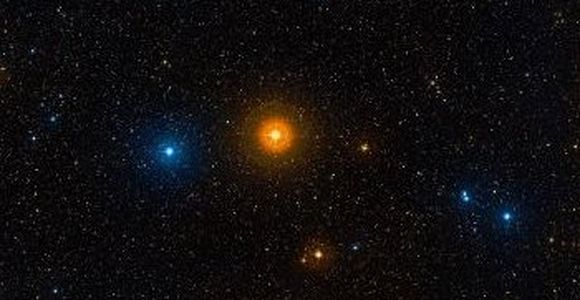
Star: 119 Tauri (CE Tau) (Image Credit: Sloan Digital Sky Survey)
Galaxy: NGC 1964
Telescope, Medium/Challenge
There are no relatively conspicuous galaxies of note crossing the south meridian line, those that do are quite difficult, inconspicuous wisps (unless you are imaging or have a very large backyard scope). Perhaps try hunting for NGC 1964, a barred spiral galaxy in the constellation Lepus, located crouching below Orion.
This 10.7 mag galaxy lies 65 million light years away from Earth and is approximately 100,000 light years across. At its centre lies a super massive black hole, with estimated mass of 2.5 million solar masses. The galaxy features two tightly wound inner spiral arms within a disk with high surface brightness and two outer, more open spiral arms that originate near the inner ring. NGC 1964 is the main galaxy in a group of galaxies, known as NGC 1964 group, which also includes the galaxies NGC 1979, IC 2130 and IC 2137.
Look for it January 15th, 21:55h due south 1.5 degrees lower left of beta leporis (Nihal) and fractionally left of a mag 9.65 orange star Do not mistake it for the globular cluster M79, which lies well south of Nihal
Nebula: Messier 78 (or NGC 2068)
Small Telescope, Medium
A reflection nebula in the constellation Orion. Again we shall steer clear of the obvious –M42 Orion nebula, and instead take a look at M78. This was discovered by Pierre Méchain in 1780 and was included by Charles Messier in his catalogue. M78 is the brightest diffuse reflection in the sky and lies in a group of nebulae that include NGC 2064, NGC 2067 and NGC 2071. This group belongs to the Orion Molecular Cloud Complex located 1,600 light years distant from Earth.
M78 is easily found in small telescopes as a hazy patch which also involves two stars of 10th magnitude. These two stars, HD 38563A and HD 38563B, are responsible for making the cloud of dust in M78 visible by reflecting their light The nebula is pretty easy to find as it is located only about 2 degrees north and 1.5 degrees east of Alnitak, the easternmost star of Orion’s Belt. Due south Jan 16th – 22:00h.
Cluster: The 37 cluster (NGC 2169)
Binoculars/Telescope, Easy/Medium
It would have been very easy to go for the Pleiades, however I'd like to highlight an object you may not have heard of, yet it certainly deserves scrutiny.
Possibly discovered by Giovanni Batista Hodierna before 1654, it was certainly observed by William Herschel on October 15, 1784. At moderate magnification, you’ll see NGC 2169 comprised about 15-20 stars of 7th magnitude or fainter arranged in two groups, both about 1/10 of a degree across. One group contains 6-7 stars and the other perhaps 10-12 stars. It is the arrangement of these stars that is so striking. Nicknamed "The '37' Cluster" due to its resemblance to the numerals "37". The larger group forms the letter “3” and the smaller group forms the letter “7”.
NGC 2169 is about 3,500 light years from Earth and is just 8 million years old. Due south Jan 22nd at 22:00h
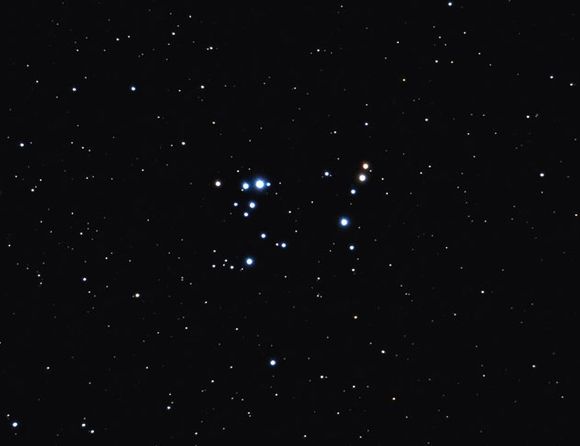
The 37 cluster (NGC 2169). (Image Credit: ESO / Igor Chekalin)
Events

Whitby School, Prospect Hill site, Main block, Room H1 (first along corridor from Hall).
Monthly meetings consist of a review the night sky for the upcoming month using a Planetarium program, talks and presentations on astronomy and space topics, discussions and plans for future events. New members are welcome.

